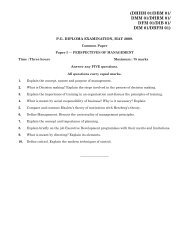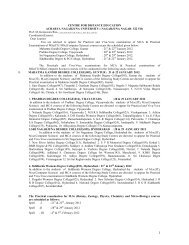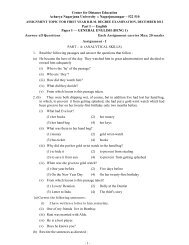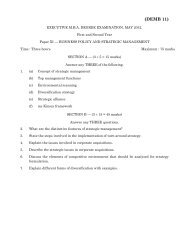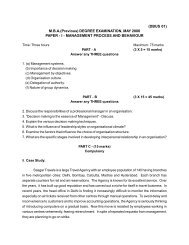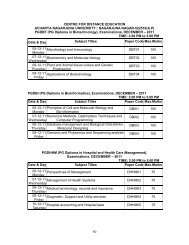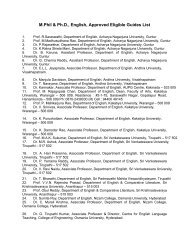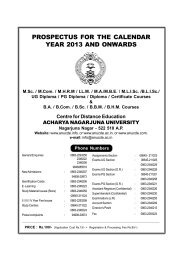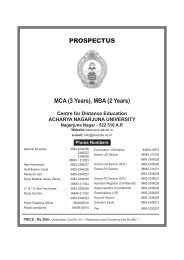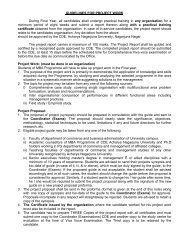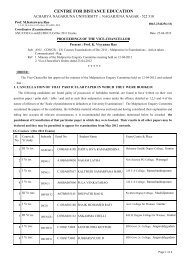II YEAR - ANUCDE
II YEAR - ANUCDE
II YEAR - ANUCDE
- No tags were found...
You also want an ePaper? Increase the reach of your titles
YUMPU automatically turns print PDFs into web optimized ePapers that Google loves.
Sipani decided to go in for a fiber glass body to his three-wheeler and he approached anautomobile consultant who had specialized in fiber glass technology. His consultant whoassociated with him in the Sunrise Automobile project justified the choice of a fiber glassbody because low investment when compared with the investment required for steel body interms of tooling cost. Die consultant further advised him that “fiber glass is not only moreeconomical but also lends itself to volume and design adaptability. In the case of deformityoccurs in steel, it is permanent but fiber glass is elastic and regain its shape” Hence, Sipaniwent for a fiber glass body for his new three-wheeled auto and branded it as ‘Badal’.Sipani launched ‘Badal’ with a price Rs. 12000 at ex-factor cost in 1977. The sunrise Autoindustry h.id secured licenses to run the Badal as a taxi in several States includingMaharastra and had enough bookings. But, Sunrise’s production of ‘Badal’ depended totallyon the power pack supplied by scooters’ India Ltd., a public sector enterprise, at the time. Asthe power pack supplier failed to fulfill his obligation, it terribly affected the productionschedule of Badal and Sunrise came across severe criticism from various quarters. Itdamaged the company’s credibility and its commitment to customers was suspected. Sipani,the proprietor of Sunrise, was branded as ‘fly-by-might trader. But, Sipani never gotdiscouraged and gave up easily. His mantra was ‘Never say Die’ in the auto business andwent on.Now, he ventured into four wheeler. He renamed his Sunrise Auto as Sipani AutomobileLtd., in 1979. This time, for his proposed four-wheeler, the UK based Reliant companyexpressed instant interest when he approached it. Reliant company was one of the largestfiber glass body makers in the world. A team of Reliant officials came to India and visited allthe automobile manufactures for searching contract for fiber glass technology. No oneshowed any interest except Sipani Automobiles and Reliant considered Sipani as the bestcandidate for its fiber glass technology In 1981, Sipani executed a contract with ReliantCompany for the fiber glass body technology and subsequently he had got governmentclearance. Then he went on to mobilizing his resources to manufacture the four-wheelerpassengercar, particularly he raised finance from the Karnataka State Industrial FinanceCorporation.Experts in the auto industry opined that the Reliant technology was 30 years old anddumped this old technology to Sipani Automobiles. Sipani, did not deny the experts opinionand convinced himself that he did not make any mistake. His very strong belief was that inan uncertain Indian Market, it was not really viable to make a Rs. 200 crores investment inorder to acquire the latest technology. His total investment was about Rs. 3 crores in his petSipani Automobile car project. So, he was able to produce a decent car with fiber glass bodyand he branched it as ‘Dolphin’. The vehicle was light weight and fuel efficient. Many usersfelt that the vehicle could be driven continuously for 5 to 6 hours (400-500 kms) withoutbreaking in the journey. The vehicle had an indigenous components of 70 per cent and hadsingle door with fiber glass body. Sipani priced the vehicle at Rs 57,500/which was aboutRs. 9000/-higher that of the price of Maruti 800 cc. He convinced that maruti’s price was notrealistic and he predicted that the Maruti’s 800 cc vehicle’s price would steadily rise. Ofcourse, his prediction was right. Maruti’s price went up to 1.6 lakhs by the close of 1980s andfurther went up to 2.25 lakhs by the middle of 1990s.By the middle of 1980s, the demand for ‘Dolphin declined and Sipani was not able tomaintain his production schedule. Meanwhile, in the middle of 80s he brought a double doorcar which was known by the brand name “Montona”. The double door ‘‘Montona” too faced lotof problems. Sipani could not maintain his production schedule as well as service back upthough there were enough bookings for his vehicles. As a result, Sipani Automobile facedsevere financial crisis and the Karnataka government issued legal notices to Sipani by thebeginning of 1990 and went to the extent of attaching the properties of Sipani Automobiles.Eventually SAL disappeared from the Indian auto industry.2(DBUS 23) NR



